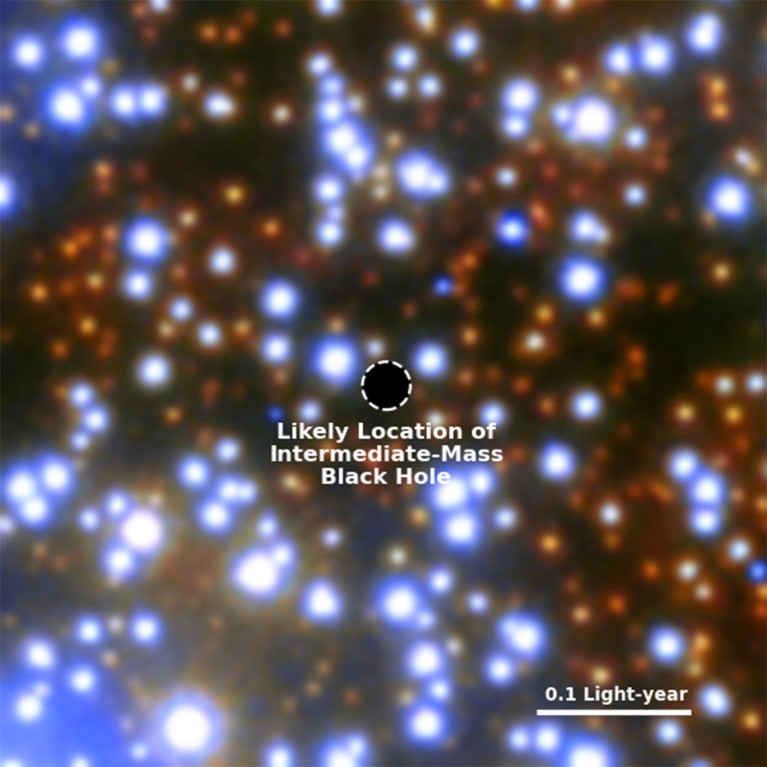By combing through two and a half decades of images from the Hubble Space Telescope archives, astrophysicists may have discovered evidence of a nearby black hole that could be at least 8,200 times more massive than the Sun.
If further studies can confirm the results, the object will be the second largest black hole found in our galaxy. It could also be the strongest contender for an intermediate black hole - an object in the enigmatic "no man's land" between the 'supermassive' black holes thought to lie at the center of most galaxies and much smaller ones that weigh about as much as a single large star.
Fast moving stars
Astrophysicist Maximilian Häberle at the Max Planck Institute for Astronomy in Heidelberg, Germany, and his collaborators examined more than 500 images of ω Centauri, a dense star cluster with 10 million stars about 18,000 light-years (5.43 kiloparsecs) from the solar system. The images were taken primarily to calibrate the Hubble Telescope's instruments over the years.
The team stitched the images together to reconstruct the motion of more than 150,000 stars in the cluster. Most stars moved as the theoretical models predict, says Häberle. “But then there were some who moved faster.” Seven stars, all near the center of ω Centauri, were moving too fast to be held by the cluster's gravity alone.
This suggests that the stars were accelerated by the gravitational pull of a massive object, such as a black hole. From the speeds of the stars, it would have to weigh at least 8,200 solar masses, but could weigh as much as 50,000 suns. “We didn’t know beforehand whether we would find it or not,” says Häberle. “It was a little risky and we wouldn’t have been able to find anything.”

“It's a difficult experiment,” and the evidence for the existence of a black hole is “still very far from conclusive,” says Gerry Gilmore, an astrophysicist at the University of Cambridge, UK. In particular, the data does not yet show any signs of the trajectories orbiting one another as expected from a massive object, as would be the case for stars orbiting a massive object. In the case of Sagittarius A*, the 4.3 million solar mass black hole at the center of the Milky Way, Years of observation found irrefutable evidence of such curved paths - one for the two leading researchers in 2020 Nobel Prize received. The Gaia Space Telescope has also discovered some dormant, star-shaped black holes from the motion of a single companion star 2.
Most black holes have been discovered in the last five decades using radiation such as X-rays or radio waves 3produced by superheated gas spiraling into the hole. The first hint of Sagittarius A*'s existence was actually a radio cold source - although not a very bright one. But no such emissions were found in ω Centauri.
Enigmatic middleweights
The mass of the candidate object in ω Centauri would clearly put it in the range of intermediate black holes, generally between 100 and 100,000 solar masses. So far, the only solid evidence for black holes in this area comes from the detection of gravitational waves produced by two merging black holes. One such event observed in 2019, is said to have created an object of about 150 solar masses.
The search for medium-sized black holes has a long history of claims that are later debunked. Astrophysicists have long suspected that some sources of “ultraluminous” X-rays could be black holes of this size. But most of these candidates have now been shown to be neutron stars, which shine unusually brightly by absorbing superheated material from a companion star. "These are most likely associated with 'normal' young binary systems," says Giuseppina Fabbiano, an astrophysicist at the Harvard-Smithsonian Center for Astrophysics in Cambridge, Massachusetts.
Big questions remain - including how some black holes become supermassive and whether they are the result of multiple mergers, starting from stellar black holes and continuing through intermediate masses like that of the candidate in ω Centauri.
The team is now planning follow-up studies with the James Webb Space Telescope, says Häberle. While the Hubble data will only show how the stars move across the field of view, the stars' spectra will show how they are moved along the line of sight, allowing astronomers to reconstruct their velocities in full 3D.

 Suche
Suche
 Mein Konto
Mein Konto

